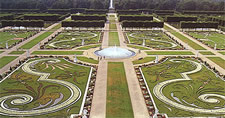 | | City
Hall with Lake Maschsee in the City Center, Hannover. | Germany:
a great country brimming with great cities. Picturesque
Munich comes even more alive during Oktoberfest, while the rich bloodlines of
Mercedes-Benz and Porsche pulse through the veins of legendary Stuttgart.
And, of course, historic Berlin dazzles as the "Manhattan" of its mother
country. And in addition to these powerhouse metropoli, the centrally located
city of Hannover stands out with a unique combination of vibrant public gardens,
to-die-for shopping centers and world-class convention facilities, all flavored
by a hip, university-town attitude.
Now,
to the German neophyte (such as I was at the commencement of my visit), Hannover
is a terrific place to land. With a population of more than half a million, the
centrally located city hosted the 2000 World Exposition, and plays host to several
other conventions of worldwide significance, including the Marksmen's fair, the
industrial Hannover Fair and CeBIT, the world's largest computer fair. Perhaps
more important to the souvenir hunter, however, is Hannover's bragging rights
to the largest all-pedestrian shopping area in Germany, with hundreds of shops,
cafes and department stores along the famous Georgestrasse and surrounding walkstreets
in historic Old Town. Not a bad place to base oneself (we could recommend Hotel
Kaiserhoff, directly across from the Central rail station - www.centralhotel.de).
Venturing about Hannover will find you many a treasure, including a variety
of art and historical museums as well as some truly splendid public recreational
areas. Bring comfy shoes, though, so you can take a guided tour along a 4.2-km
painted stripe called "The Red Thread," which winds along the pavement
around the downtown area, taking you to 36 points of interest. It's a great activity
for your first morning in Hannover.
Now,
the only way to make a beautiful afternoon in Hannover even more beautiful is
to spend it savoring the sights and smells of the Royal Gardens of Herrenhausen.
Located just a few kilometers north of downtown Hannover on the site upon which
Duke John Frederick built his summer residence, the 370 acres of the Royal Gardens
are vast, vibrant and meticulously maintained.
 |
| Royal
Gardens of Herrenhausen. |
Herrenhausen's
"Great Garden" is considered to be one of the most beautiful baroque
of gardens, while the George Garden is styled as an old English garden, with rolling
expanses of green flanking a two-kilometer-long walking/riding path. Other features
of the Royal Gardens of Herrenhausen include the Garden theatre (where live outdoor
dramas are still staged in the summers), the Rainforest House in the Berggarten
and the breathtaking Grotto, a small, three-room secondary structure that at one
time was relegated to a refreshment stand, but that recently was transformed into
a mirrored wonderland of fantasy by the late French artist Niki De Saint Phalle,
who, incidentally, left her artistic marks in several other places about Hannover.
Being
the capitol of the State of Lower Saxony, Hannover has several official buildings
of note, the grandest of which being the New Town Hall, a gorgeous, Wilhelmian
structure which features, among other things, a unique double-decker domed atrium
that you can take a guided ascent, if you have the stomach. The atrium also houses
incredible scale models of the city, one that accurately depicts the bustling
metropolis of today that is joined by another that shows how it appeared back
in 1689, when Hannover had 10,500 inhabitants. Two other models show the sobering
contrast between what Hannover looked like in 1939, when its population had swelled
to 450,000, and the devastated, war-torn city in 1945, with 90% of all structures
damaged or destroyed, and its population shorn to just 250,000.
 |
| Bahnhofstreet
with Main Train Station. |
The
capital city also has public transit down to an art -- literally. The city's train
and bus network, called Ustra, features clean, cool-looking "Stadtbuses"
and rail cars, each with glassy interiors and features such as news updates and
stop information displayed on flat color monitors. In preparation for the 2000
World Expo, several stations and bus stops were entrusted to noted artists and
architects such as Frank Gehry, Elvira Bach and Ettore Sottsass, resulting in
designs ranging from the abstract to the amusing. A taxi ride to each of these
depots could be an interesting morning activity in itself. For more info, click
on www.uestra.de.
For
more information on the enchanting city of Hannover, check out www.hannover-tourism.de.
|